Outline of Nishinomiya City(西宮市の概要)
更新日:2024年7月1日
ページ番号:39463716
Outline


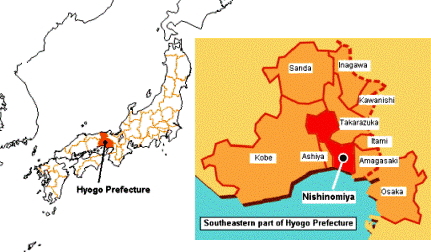
Nishinomiya, the city for “Living, Culture and Education” with a population of approximately 490,000 and an area of 100.18 sq km, lies nestled between Osaka and Kobe in the southeastern section of Hyogo Prefecture. In addition to its cultural and educational facilities, Nishinomiya is surrounded by the natural splendor of the Rokko Mountain range to the north and beautiful Osaka Bay to the south.
Nishinomiya's rich heritage is revealed in the historical landmarks dotting the region and in the mention of the area in historical records dating back more than 1,000 years. The city is also famous for Koshien Baseball Stadium, which hosts the High School Baseball Tournament. Food processing accounts for 80% of Nishinomiya’s industries with sake production at its core. Food processing figures rank top-class nationwide. Also, due to convenient transportation via the Hanshin Expressway to the south and the Chugoku Expressway to the north, Nishinomiya meets industry transport requirements, thereby inciting growth in both transport and communication businesses.
Though the Great Hanshin-Awaji Earthquake of January 1995 brought devastating damage to the city, recovery work has been undertaken and advancement has been made in creating a safer city.
In April 2008, the city became a core city and aims to achieve further growth as an urban core of the Hanshin region.
Population
483,272(as of March 1, 2024)
Number of Families
220,399 families (as of March 1, 2024)
Area
100.18 k㎡ (as of March 1, 2024)
Location
Nishinomiya City is located in the southeastern part of Hyogo Prefecture. To its south is Osaka Bay; Amagasaki and Takarazuka are to the east; Ashiya City to the west, and to the north Nishinomiya meets Kobe City and the Rokko Mountain range.
Climate
Southeastern part of Hyogo Prefecture:
In the Seto Inland Climate Zone, the weather is moderate with a small precipitation throughout the year, while a characteristic phenomenon of the urban climate is observed. The air is dry with small precipitation and low humidity and the city’s proximity to the sea helps to moderate the temperature a bit. Days in winter, in particular, is sunny and dry. In a rainy season in early summer, torrential rainfall occurs due to the presence of the Rokko mountain range and warm moisture-laden air moving up the Osaka bay.
Location of City Hall
Nishinomiya City Hall
10-3 Rokutanji-cho, Nishinomiya City, Hyogo Prefecture, 662-8567
Phone:0798-36-5000
ダウンロード
![]() アウトライン西宮(Outline Nishinomiya English)(PDF:12,255KB)
アウトライン西宮(Outline Nishinomiya English)(PDF:12,255KB)
History
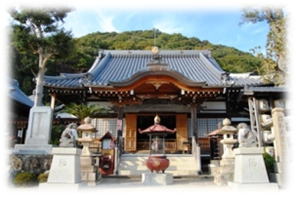
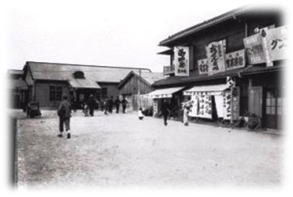
[Primitive Age]
From rice-farming villages and excavated remains of villages in the city, it is known that people had already lived in Nishinomiya in the Yayoi era (from about 500 B.C. to about 300 A.D.) and carried out farming and fishing.
[Ancient Times]
Kofun or graves of powerful clans built in the Kofun era (from about the middle of the 3rd century to the 7th century) can be found in the city. In the “Nihon Shoki” (The Chronicles of Japan) and “Manyoshu” (A Collection of Ten Thousand Leaves) edited in the Nara era (710~784) the names of Hirota Shrine and Muko-no-tsu appear. Muko-no-tsu, located around present day Tsuto, was a major port of the Yamato state. Kochi-jinja shrine, Kanno-ji and Jurin-ji temples were built in the Heian era (794~1185), and a shrine town developed around Ebisu-sha (Ebisu shrine) which originated as a branch shrine of Hirota Shrine.
[Middle Ages]
When new Buddhism spread in the Kamakura era (1185~1333), many temples were built in Nishinomiya. They included Jokyo-ji temple of the Jodoshu sect, Gyoko-ji temple of the Jodoshinshu sect, and in the period from the end of the Kamakura age through the Muromachi era (1336~1573) Rokutan-ji, Kaisei-ji and Mosho-ji temples of Zen sects. Around Nishinomiya-jinja shrine a town was created, and through kugutsushi (puppetry) which was the forerunner of ningyo joruri (puppet theatre), devotion to the god Ebisu spread throughout Japan.
[Modern Age]
During the Edo era (1603~1867) Nishinomiya and Namaze prospered as lodging towns. The sake industry which had begun in the Muromachi era developed further, and the tasty Nishinomiya sake which was prized in Edo (former Tokyo) was shipped in barrel-carrying ships to Edo from Nishinomiya and Imazu ports. At the end of the Edo era ‘miya-mizu’ water was discovered and sake brewing developed even further. Farming and fishing also prospered. In the 18th century, the city had grown to have a population approaching 10,000 and came under direct control of the Bakufu (the Shougunate government). In the northern area of Najo and Yamaguchi, papermaking and bamboo craftwork flourished.
[Modern / Present Age]
With the advancement of modernization in the Meji era (1868~1912), railway lines opened in Nishinomiya, and in Meiji 7 (1874) Nishinomiya Station was opened. At the end of the Meji era, the Hanshin Railway line opened, and at the end of the Taisho era (1912~1926) the Hankyu Railway line opened. Leisure facilities, including the Koshien Baseball Stadium, as well as housing were constructed, resulting in the Hanshin region (the area between and including Osaka and Kobe) developing into a residential zone.
On April 1, 1925, Nishinomiya was officially designated as a municipality and Nishinomiya City was born. At that time, the total area of the city was 5 km with a population of 34,000 people. Overcoming recovery from World War II and the Great Hanshin-Awaji Earthquake, etc., Nishinomiya has today grown to be a large city with a population of 480,000.
Great Hanshin-Awaji Earthquake
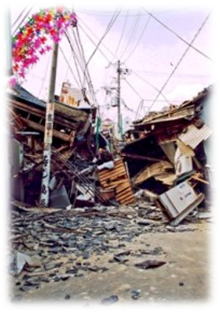
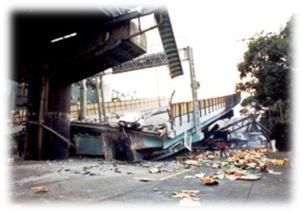
The Great Hanshin-Awaji Earthquake struck Nishinomiya at 5:46 a.m. on January 17, 1995. It devastated our city all at once, claiming many precious lives and damaging property. From that day onward, enormous efforts were made for emergency relief, recovery and reconstruction.As we move forward, we need to be reminded of what the disaster has brought to us. We are responsible to provide our findings to other organizations and to the younger generation.
Detail of the Earthquake
- Date: 5:46 a.m., January 17, 1995
- Force: 7.3 on the Richter scale
Shindo 7 on a seismic intensity scale used in Japan indicating it was a violent
Earthquake
- Epicenter:North of Awaji Island(Longitude: 135º02’E、Latitude: 34 º36’N)Depth: 16 kilometers below the earth’s surface
Damage in Nishinomiya
- Number of citizens killed: 1,146 including citizens died of reasons triggered by the quake and died outside the city
- Number of houses destroyed: Completely damaged 34,136 households / Partially destroyed 27,102 households
- Evacuation areas: A maximum of 194 sites were used as a shelter on January 20, 1995
- Number of people seeking shelters: A maximum of 44,351 on January 19, 1995
- Number of fires following earthquake: 41 incidents
City Assembly
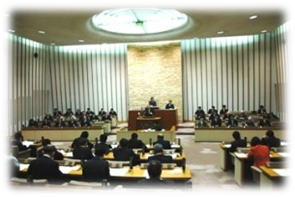
The Nishinomiya City Assembly consists of forty-five assembly members elected by the citizens. They meet regularly four times a year in June, September, December and March. In order to reflect the citizens’ opinions in civic affairs, legislators debate and determine such issues as budgets and ordinances and aim to achieve a better municipal administration and improve the welfare of the citizens. Extraordinary sessions are held on an as-needed basis.
A steering committee is set up to operate each session more efficiently. Four standing committees examine proposed bills in detail from expert viewpoints. There are General Affairs Committee, Citizens’ Affairs, Culture and Education Committee, Welfare Committee, and Construction Committee. When necessary, special committees are established to research specific issues.
Industry
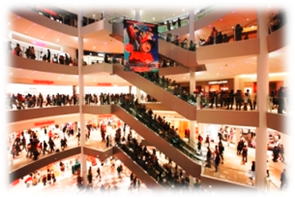
[Commerce]
Nishinomiya City’s small businesses were centered around the main stations of the Hanshin, Hankyu and JR railway lines, however, in recent years many large-scale retail businesses have opened stores along major roads.One core of the city is the area around Hankyu Nishinomiya Kitaguchi Station. In 2001, the ACTA Nishinomiya complex which includes large retail stores, specialty stores and public facilities was completed as a post-earthquake recovery project, in 2005, the Hyogo Performing Arts Center was opened to ease the emotional suffering of the earthquake and to revive the arts, and in 2008, Hankyu Nishinomiya Gardens, the largest shopping complex in west Japan, was opened. The completion of these projects has increased vitality and excitement in the city year by year. Also, in 2003, in the Hanshin Nishinomiya area which is the western core of the city, EBISTA Nishinomiya and the redeveloped AVIS PLAZA were completed. In 2009, in the Koshien area, KidZania, a facility where children can experience doing many kinds of work was opened. The increase of these large-scale commercial facilities is hoped to attract consumers not only from within the city but also from outside.
On the other hand, present shopping markets and small retail stores are needed to play the essential role of keeping vitality in local communities.
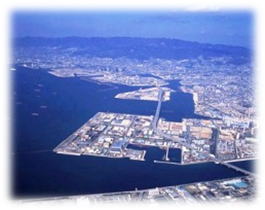
[Industry]
As of 2007, Nishinomiya’s industry was ranked 8th in the prefecture when calculated on shipment value. Beverages and processed food accounted for 70%. Beverage and food industries centered around the local sake industry are located from the seafront area to the inland regions of the city. There are many small and middle-size companies operating in the reclaimed land areas of Naruo-hama and Nishinomiya-hama. Companies mainly in the logistics business operate in the northern area of the city,
Over the long term there appears to be a declining trend in the value of shipped manufactured products, the number of businesses, and number of employees in Nishinomiya’s industries.
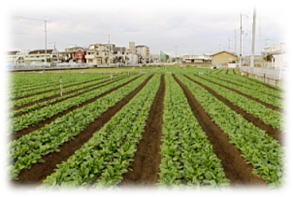
[Agriculture]
Approximately 70% of Nishinomiya’s farmland is located within the urban district and is typical city farming. In the northern area, agriculture focuses on rice farming, while in the southern area which is near Osaka and Kobe which are large consumer cities, vegetable farming is carried out in all seasons.
With the growth of urbanization and the reduction of farmland, the city’s agriculture faces a critical situation. The protection of farmland and securing successors for farming are also serious problems.
Special Products
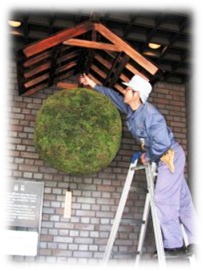
[Sake Brewing]
The southern region of Hyogo Prefecture is referred to as Nada, and is an area where sake brewing thrives. Areas where there is a group of sake brewers are called ‘Go’ and in Nada there are 5 ‘Go’ called ‘Nada Go Go’. Among these are the ‘Nishinomiya Go’ and ‘Imazu Go’ which are in Nishinomiya. Literary reference to Nishinomiya sake brewing appeared in 15th century. In the 17th century, sake brewing began as an industry, and in the 19th century, ‘miya-mizu’ was discovered. ‘Miya-mizu’ is water that comes from underground water streams that flow from the Rokko mountain range and spring up on south side of Nishinomiya-jinja shrine. The word ‘miya-mizu’ is a combination of ‘miya’ meaning shrine, and ‘mizu’ meaning water. This pure, cold water helped the sake industry develop as large it has. ‘Miya-mizu’ is water that comes from underground water streams that flow from the Rokko mountain range and spring up on south side of Nishinomiya-jinja shrine. The word ‘miya-mizu’ is a combination of ‘miya’ meaning shrine, and ‘mizu’ meaning water. This pure, cold water helped the sake industry develop as large it has.
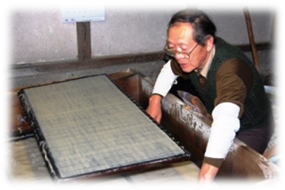
[Najio Washi - Najio Japanese paper]
There was literary reference in the 17th century to the Najio district in the northern part of the city as being the home of ‘washi’ (Japanese paper). At present, there are few people left to pass on the washi-making tradition. However, a washi learning hall has been built next to a local primary school where children and others can learn how to make washi and pass on the washi-making tradition.
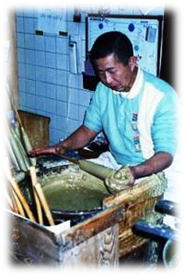
[Japanese candles]
Japanese candles were manufactured in the Edo era as the Himeji clan industry. At present, the only business in Hyogo Prefecture producing them is Matsumoto Shoten which in Meiji 10 (1877) became an independent branch of a Himeji manufacturer. The business moved to Nishinomiya after World War II and mainly produces candles for use in temples. However, in recent years the company’s candles have become widely popular for interior decoration and use.
City Declarations
Nishinomiya City has made the following declarations; Cultural, Educational and Residential City Declaration (1963), Peaceful and Nuclear-free City Declaration (1983) and the Environmental Learning City Declaration City (2003) and carries out projects in accordance with these declarations.
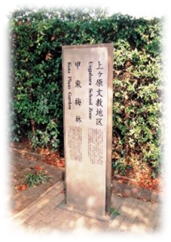
[Cultural, Educational and Residential City]
In 1963, Nishinomiya City made the “Cultural, Educational and Residential Declaration” with the goal of maintaining its beautiful scenery, protecting and cleaning its environment, promoting education, carrying out urban development suited to the city and to promote the social welfare of its citizens. The 10 universities/colleges in the city play a major role in bringing out the distinctive features of the city as an ‘cultural, educational and residential city’. With these colleges as a collective important cultural asset, and through cooperation between the city and colleges as well as inter-college exchange and exchanges between colleges and the city’s citizens, Nishinomiya promotes the creation a culturally attractive city through its ‘College Town Nishinomiya’ projects.
Also, blessed with its beautiful natural surroundings of mountains, rivers and sea, the city wants to develop beyond the ‘Cultural, Educational and Residential City’ course it has taken to create a culturally rich Nishinomiya with the ‘Nishinomiya – The City that Encounters♪Music’ as one concept for promotion in city planning.
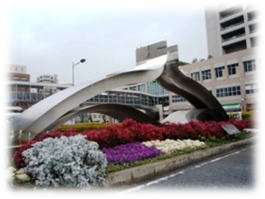
[Peaceful and Nuclear-free City]
In 1983, Nishinomiya was one of the first cities in Hyogo Prefecture to present a Declaration as a Peaceful and Nuclear-free City. The city declared its support for the total eradication of nuclear arms and perpetual world peace. Through various activities, including exhibitions regarding the destructive nature of nuclear weapons, bus tours to Hiroshima every August, and awareness projects for local residents, the city continues in its efforts toward realizing a peace-loving society.
In 1996, to commemorate the 50th anniversary of end of World War II, the monument “Heiwa no Kokyo” (Peaceful Exchanges) was erected in the square south of JR Nishinomiya Station. The peace monument was erected to symbolize the goal of creating a society where people can live in peace, to pray for peace and teach future generations of it preciousness, as well as wishing for the city’s recovery from the Great Hanshin-Awaji Earthquake disaster.
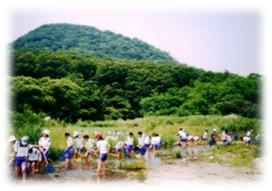
[Environmental Learning City]
In 2003, the city pioneered the concept of having all who live, study and work in Nishinomiya participate and cooperate in environmental learning to promote sustainable urban and community development in line with the “Environmental Learning City Declaration”. The city continues its goal of creating urban and community sustainability for the 21st century centered on the participation and cooperation of citizens, businesses and local government authorities.
In 1992, Nishinomiya with its unique environmental learning system started the EWC (2011- Earth Watching Club – Nishinomiya) as a program for children to independently, continuously and comprehensively learn about the environment. In 1998, the “ECO Card / ECO Stamp System” was introduced for all children attending elementary schools in the city. This later developed into a system where anybody at anytime could participate in environmental learning.
Sister City and Friendly Cities Abroad
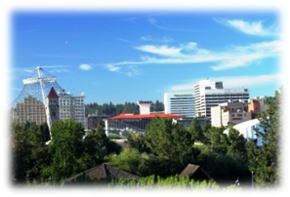
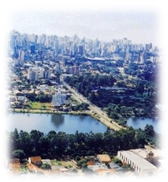
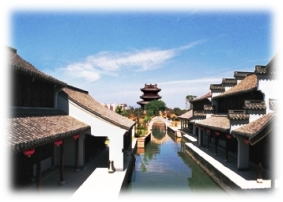

Nishinomiya continues friendly exchange with its sister cities Spokane (Washington, USA / ties established1961), Londrina (Parana, Brazil / ties established 1977), Shaoxing (Zhejiang, China / ties established 1985), and Lot-et-Garonne Province and Agen (Aquitaine Province, France / ties established 1992).


PDF形式のファイルを開くには、Adobe Acrobat Readerが必要です。
お持ちでない方は、Adobe社から無償でダウンロードできます。
![]()
